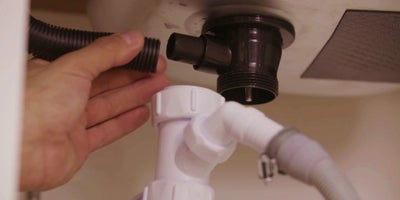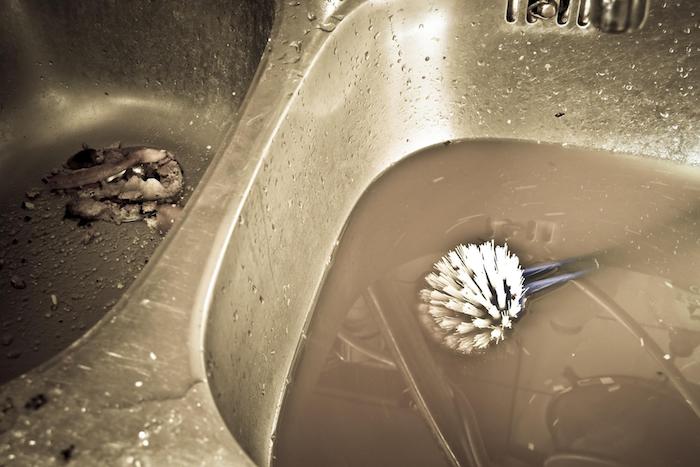Steps To Easily Fix A Slow-Draining Sink
Steps To Easily Fix A Slow-Draining Sink
Blog Article
We've discovered this article pertaining to Solved! How to Fix a Slow Sink Drain directly below on the web and concluded it made perfect sense to relate it with you over here.

Intro
We've all existed: You're brushing your teeth or washing your hands, and you observe the water pooling in the sink. As opposed to quickly swirling away, it lingers, transforming your once-refreshing morning routine right into a mini overload scene. A slow-draining sink isn't just annoying; it's usually an indication of bigger plumbing issues hiding underneath the surface area. The good news is that the majority of slow-draining sinks can be repaired with a little knowledge, a few basic devices, and some patience. Ready to tackle this job head-on? Allow's roll up our sleeves and dive right in.
Comprehending the Sources Of a Slow-Draining Sink
Before you start poking around in your pipes, it helps to know what may be creating the stagnation. Recognizing the origin makes it simpler to choose the appropriate repair.
Usual Culprits Behind Slow Drainage
So, what's clogging points up? Typically, it's a mix of daily particles-- believe hair, soap scum, tooth paste deposit, and leftover food bits. Over time, these little bits build up and hold on to the pipe wall surfaces, slowly narrowing the flow and making it harder for water to travel through. In many cases, natural resource from tough water can likewise add to the gunk, producing the best storm for persistent blockages.
When is it Time to Do Something About It?
If you observe the water draining pipes slower than common, it's an excellent idea to intervene faster instead of later on. Waiting as well long might result in finish blockages, undesirable odors, and even pipeline damages. If the water takes more than a few seconds to remove after switching off the faucet, consider it a warning and prepare yourself to place on your do it yourself hat.
Devices and Products You'll Require
The right tools make all the difference. The good news is, you will not require a fully stocked plumbing professional's van to get the job done.
Essential Devices for Do It Yourself Fixes
A plunger is your best starting point. A small, sink-sized bettor develops suction that can remove small blockages. For even more relentless obstructions, a drainpipe snake (in some cases called a plumber's auger) works wonders. A pair of gloves, a flashlight, and perhaps a pair of protective safety glasses are additionally convenient.
Advised Cleaning Solutions
Mild dish soap and warm water can aid break down oily build-up. A blend of baking soda and vinegar is a time-tested natural remedy, and chemical cleansers provide a more environment-friendly technique. Maintain chemical drainpipe cleaners as a last resort, as they can be rough on your pipes.
Safety And Security First: Precautions and Preparations
Before you launch into unclogging mode, think of security. You're handling potentially dirty water and debris, so slip on a set of handwear covers. If you're utilizing chemical cleaners, guarantee the area is well-ventilated and comply with the guidelines on the label.
Protective Equipment and Workspace Configuration
Lay down some old towels or dustcloths around the sink area to catch dashes. Eliminate any type of products that could enter your method, like soap dispensers or toothbrush owners. Ensure you have excellent illumination-- order a flashlight if required.
Step-by-Step Overview to Taking Care Of a Slow-Draining Sink
Currently, let's enter the nitty-gritty. This step-by-step process will direct you through straightforward strategies to restore your sink's drain.
Step 1: Get Rid Of and Clean the Stopper
Frequently, the stopper (that tiny plug you lower to block water) is the first wrongdoer. Remove it meticulously and clean off any kind of hair or substance entraped around its base. Rinse it extensively prior to putting it back in place.
Action 2: Make Use Of a Plunger to Displace Debris
Got that plunger prepared? Setting it over the drainpipe and give it a few firm pumps. The idea is to produce suction that can loosen up any obstruction. If you see littles particles drifting up, you get on the best track.
Action 3: Try a Drainpipe Snake or Cord Hanger
If the plunger doesn't suffice, it's time to bring out the drain serpent. Delicately feed it into the drainpipe and spin as you go. You may really feel some resistance-- that's likely the obstruction. Maintain twisting and drawing till you get rid of the obstruction. If you do not have a drainpipe serpent, a straightened wire wall mount can work in a pinch.
Tip 4: Apply a DIY Drain Cleaner
An all-natural cleaner made from baking soft drink and vinegar can break down residual grime. Pour half a cup of cooking soft drink into the drainpipe, complied with by half a cup of vinegar. Let it fizz for around 15 mins, then flush with hot water. This chemical reaction frequently does marvels for small clogs.
Tip 5: Reassemble and Evaluate the Sink
Put whatever back together and run the faucet. Does the water currently swirl away at a commendable rate? If yes, offer yourself a pat on the back. Otherwise, do not anguish-- there are still a couple of more tricks up your sleeve.
Alternate Approaches for Stubborn Clogs
Not all obstructions are created equivalent. If your sink still rejects to comply, consider these alternate options.
Baking Soda and Vinegar Approach
We already discussed this, but it's worth noting again. This gentle, eco-friendly technique is more secure than chemical cleaners and commonly rather efficient.
Chemical Drainpipe Cleaners
Enzyme-based cleaners use all-natural microorganisms to digest raw material. They're an exceptional selection if you're aiming to prevent extreme chemicals. Just remember, they might take a bit longer to function their magic.
Chemical Drainpipe Cleaners: Pros and Cons
Chemical cleaners can blast through challenging clogs fast, however they're not without disadvantages. They can create heat and fumes, damages pipes if made use of exceedingly, and pose environmental dangers. Use them moderately, and always adhere to the instructions very carefully.
Preventive Measures to Maintain Your Sink Flowing
Avoidance is the very best treatment. By taking on a few easy behaviors, you can maintain your sink from slowing down in the first place.
Regular Cleaning Habits
Clean down the sink basin and fixture area regularly. Eliminate hair or food particles prior to they have a chance to wash down the drain.
Preventing Damaging Substances Down The Tubes
Hesitate before discarding coffee premises, grease, or fibrous vegetable scraps down the sink. These offenders cling to pipeline wall surfaces, developing clogs over time.
Routine Upkeep Checks
Set up a fast regular monthly evaluation. Run hot water via the sink for a couple of mins, taking notice of the circulation. If it appears slow, act quick before it ends up being a full-blown blockage.
When to Call a Specialist Plumber
In some cases, no matter exactly how tough you attempt, that block simply will not budge. That's when it's time to generate the pros.
Indications That Indicate a More Severe Concern
If your sink drains slowly in spite of several attempts, or if you observe water supporting in various other fixtures (like your shower or bathroom), you might have a more severe plumbing issue hiding much deeper in the system.
Stabilizing DIY Efforts with Professional Help
While do it yourself can conserve you cash and offer a sense of achievement, there's no pity in calling a specialist. An expert plumbing technician can examine your entire pipes configuration, guaranteeing there's no underlying damages or long-lasting problem that can cost you more down the road.
Comparing Prices and Long-Term Solutions
Before making a decision, think about the big picture. A low-cost, quick fix may address the issue briefly, however buying a much more irreversible solution might conserve you money and stress in the future.
Weighing the Costs of DIY vs. Specialist Fixes
Do it yourself fixes usually cost little bit greater than the price of a plunger or a bottle of cooking soft drink. Specialist solutions, on the other hand, featured a cost however may protect against repetitive issues and expensive repair work later on.
Buying High Quality Fixtures and Upgrades
If your sink's style contributes to regular clogs, it may be worth upgrading to higher-quality components or changing the pipes design. Consider this an investment in your home's functionality and comfort.
Verdict
A slow-draining sink can seem like a minor irritation, however it's usually an indication that your pipes needs a little TLC. By understanding the root causes, employing the right tools and strategies, and devoting to straightforward safety nets, you can maintain your sink streaming freely. And when all else falls short, never ever hesitate to hire an expert-- your home's pipes deserves the financial investment in treatment and maintenance.
Three Common Ways to Fix a Slow Drain
Baking Soda Method
Boil a full pot of water. Measure out cup of baking soda and pour it down the drain. Then take cup of the magical cleansing substance known as white vinegar and drop that down there too. Allow the mixture to fizz in the drain for five minutes as the vinegar and baking soda combine. Now dump in that whole pot of boiling water. This combination of cleaning substances should clear out anything that is causing your sink to drain slowly. If it doesn t...
Zip-It
If the baking soda method doesn t clear out your drain, it may be because a significant amount of hair and/or other debris has collected there and you need to remove it. Purchase a Zip-It tool at any home improvement or hardware store and insert it into your drain. It will catch any collected hair or debris that s blocking the flow of water. Pull it out. If it s got a big clump of hair, etc. on the end, you ve probably got your culprit.
Drain Cleaner
If these methods don t work, there is the standard drain cleaner that you can also buy in a hardware store or even your local grocery store. It s better if you can use a household solution, but these drain cleaners often work in a pinch. They re very simple to use. You generally just dump them in your drain and wait. If even this method is not effective, it may be time to call the plumber.
https://www.mrrooter.com/oneida/about-us/blog/2017/july/three-common-ways-to-fix-a-slow-drain/

I stumbled upon that blog post on Solved! How to Fix a Slow Sink Drain while perusing the internet. Feel free to take the opportunity to distribute this article if you liked it. I appreciate your readership.
Call Today Report this page